Dry closets: the principle of action, variety, construction technology
Table of contents
-
1 variety of devices
- 1.1 peat
- 1.2 chemical
- 1.3 electrical
- 1.4 original device
- 2 Advantages and disadvantages
-
3 independent production
- 3.1 water model
- 3.2 peat model
- 4 conclusion
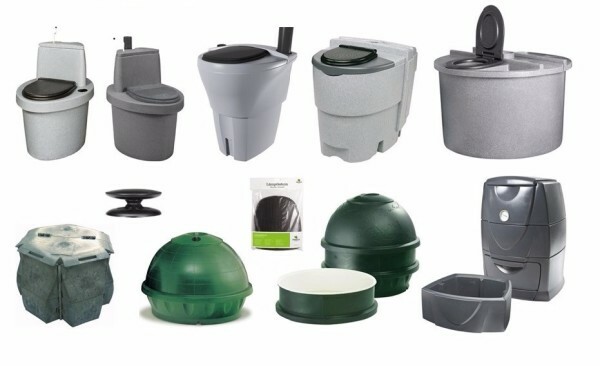
Self-contained toilet system can be very different
Choose a bio-toilet for questioning in principle is simple, but still before the purchase or construction need to learn the basic features of the species. The article provides a brief description of the operating principle of composting toilets, analyzes the pros and cons of the most popular models, and describes self-assistance technology.
variety of devices
peat
Composting toilet - this design ensures appropriate level of sanitary facilities with no access to the sewage system, cesspool pit, septic tanks, etc. When using dry closet waste is not discharged to the outside, and are accumulated in a special reservoir, and then recycled.

Options peat model
Modern bio-toilet can work on a variety of schemes. The most popular technology is composting. This method uses peat toilets, which are sometimes referred to as powders-closets:
- The basis of the construction is sufficiently large capacity. Transportable models used indoors, is small in size, while in the stationary bottom tank toilets volume may be 150 - 250 liters or more.
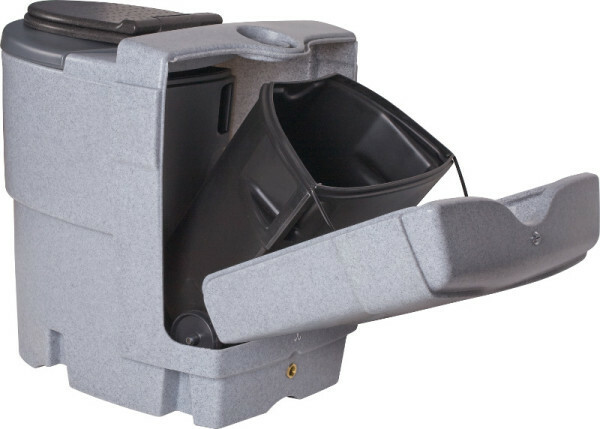
Waste reservoir
- Inside the container is composting material. In most biotoilet "seasoned" peat, but sometimes use a mixture of peat and sawdust, cellulosic molded briquettes etc.
As an alternative, forced to use cat litter - the cheapest of granulated sawdust. Just take unscented!
- After the departure of the toilet waste in the tank sprinkled with a fresh portion of composting material. We improvised models for this purpose next to put a small container with peat and ladle dosing. industrial composting toilet tank is usually equipped with a composting material to the dispenser that is activated by pressing the lever.
- As you use the container is filled with a mixture of peat with waste (Solid and liquid). In the process of filling the bottom of the tank occurs composting organic matter and its partial mineralization: due to the presence of peat as substrate thus captured a significant portion of unpleasant odors.
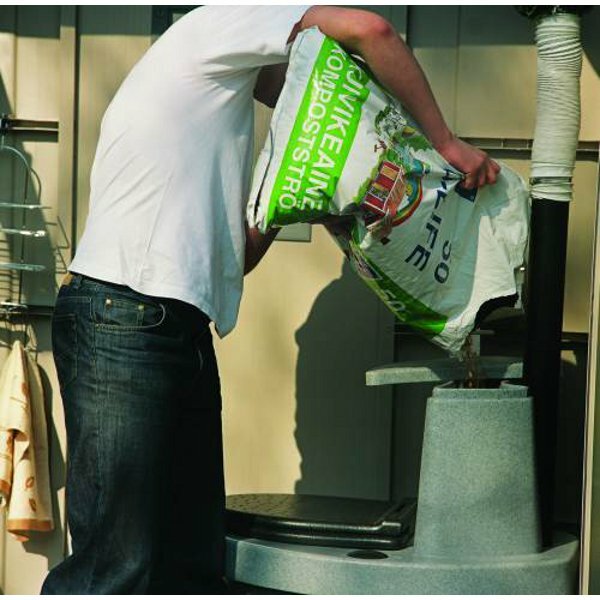
Filling the tank with peat
- Periodically, a bio-toilet is cleaned, and a mixture of peat with feces disposed of. Brochures demonstrate that the waste can be used immediately as a fertilizer, but it is not entirely correct. It is advisable to store all the contents of the toilet in the compost heap and used as fertilizer for at least one year after the bookmark.
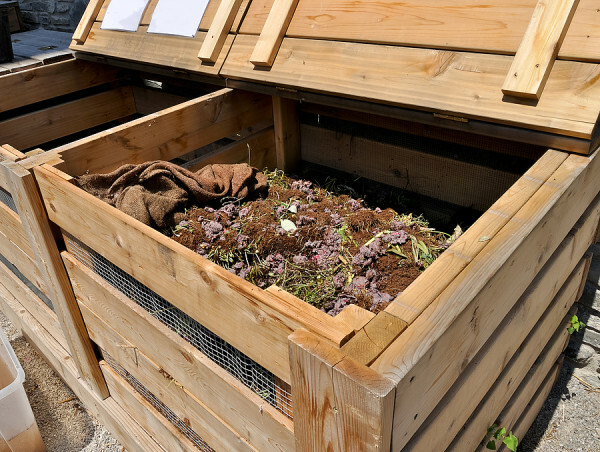
Exhaust peat is better to use immediately, but after composting
An improved biotoilet peat and may be equipped with additional devices. For example, many models is allocated a separate container for the evaporation of liquid waste. In addition, the storage tank can be equipped with a vent pipe providing evacuation of the gases produced during composting.

The presence of ventilation increases the level of comfort due to the removal of gaseous decomposition products
chemical
Biotoilet chemical (liquid) operates on a different principle. Instead of composting a mixture based on peat / sawdust used herein disinfecting and deodorant liquid.

Portable Liquid Model
Arranged bio-toilet is also quite simple:
- The bottom is the storage tankIn which, in fact, are the waste after the departure of natural needs.
- Top mounted water tank. It is filled with clean water and deodorant cleaving reagents.
- If you need to dispose of waste a cesspool or septic tank used for disinfecting ammonium or biologicals.
- If there is a possibility to drain into the sewerIt is possible to use more toxic, but more efficient formaldehyde reactants.
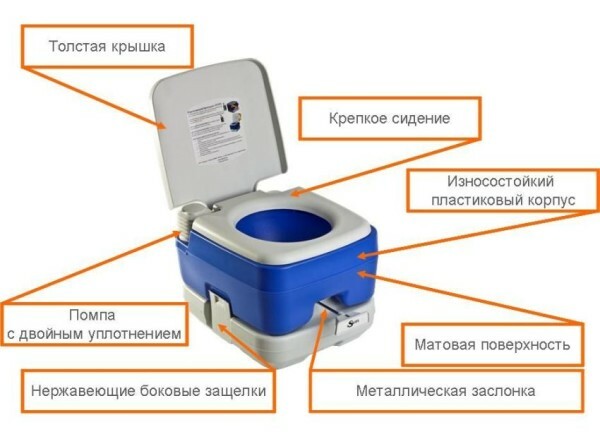
Thus biotoilet arranged with a reservoir for liquid waste
Pay attention to the type of substances used. Drain waste containing formaldehyde, can not in the compost or into the sump. This will inevitably lead to the poisoning of the soil, and possibly groundwater.
- The upper tank is mounted to the seat coverTightly closing the hole.
- Flushing is carried out via the dispenser - a piston pump, a mechanical (bellows) or electric pump.
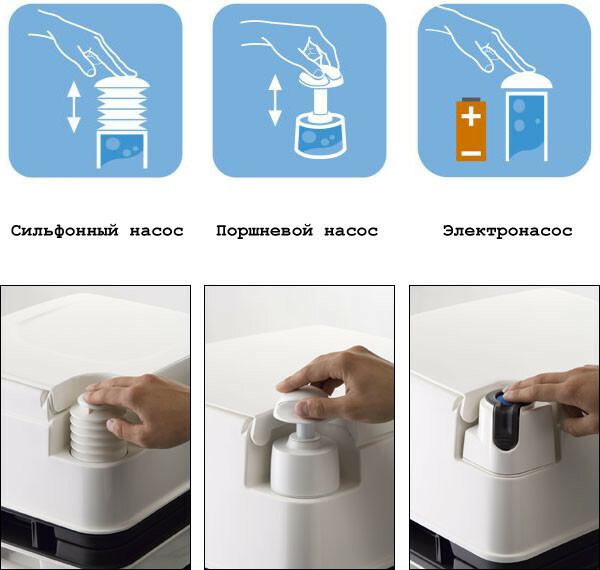
Types for flushing devices
It operates as a bio-toilet:
- As used oils are washed into the lower container. There, they are gradually decomposed and sanitized by contact with the reagents are members of the flushing fluid.

Disassembly of the upper tank to the lower tank emptying
- Because composting and recycling organics thus not performed, the type of chemical biotoilet usually completed relatively small capacity (up to 20 - 25 l). Accordingly, it must be emptied more often - the need is usually signaled by the indicator of filling the bottom of the tank.
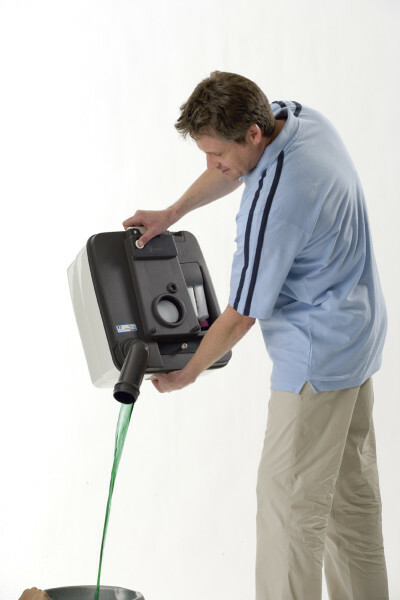
Draining waste together with waste fluid
- When filling the tank is emptied. You can use the cesspool, septic tank or sewage system.

Pouring liquid into the system
- After emptying the tank bottom is washed and filled in an upper portion of the water with new reagents. After such a "recharge" composting toilet can be used again.
electrical
If the country is a source of electricity in the bathroom possible to establish a more efficient electric composting toilet:

Appearance electric model
- The construction also comprises two tanks. The bottom is used for storing waste comprising an upper fluid for flushing.
- storage tank represented by two tanks designed for the separate storage of waste. In one part of the liquid fraction is drained, solid waste goes into another.
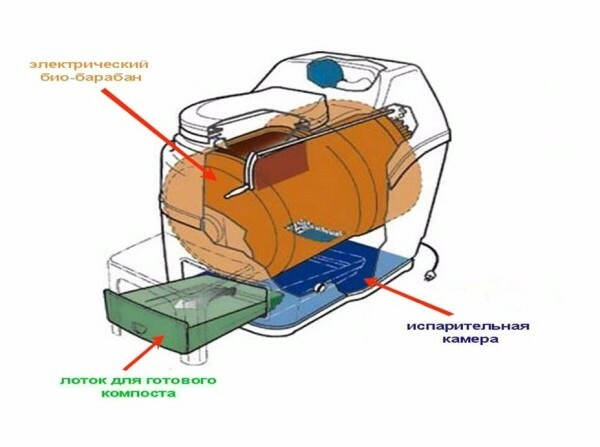
Driving apparatus with separation of waste
- The liquid fraction either evaporates or is discharged through a hose into a drain pit or drainage system.
- From solid waste by the electric compressor is removed a substantial portion of the liquidAnd then they are sealed and remain in the tank. Until the purification is carried composting container that allows the use of partially processed fecal mass as a natural fertilizer.

Compressor providing waste separation into fractions
Due to the fact that a significant portion of the liquid immediately removed from the system, a composting toilet works very effectively. Solid waste is a relatively small amount, because you can clean the bottom tank is not more than once a month.

Almost dry compost is removed from the tray
Month - it is the medium term. In fact, everything depends on the volume of the reservoir and on the intensity of use of bathrooms. For example, if the country is living a big family, you have to clean the bio-toilet at least once a week.
The disadvantages of the electrical model can be attributed to the availability of the power dependence in the network, and the complexity of the connection. If peat or liquid composting toilet can be installed in any room, by the electrical model is necessary to attach the hose to drain liquid waste and vent pipe.
original device
If you are not low on finances, and at the forefront is not the economy, and efficiency, for the garden, cottage or private home, you can buy a bio-toilet that runs on a rather original principle. These devices include:

Freezing biotoilet Biolan Icelett
- cryogenic model. They do not recycle waste, and freeze them, forming a dense briquettes small volume. When freeze completely eliminated the unpleasant smell and destroys all microorganisms. Unfortunately, such a composting toilet is effective only where there is a stable source of power, preferably with an autonomous system in the event of disconnection from the network.

thermal model
- thermal models. If the electric biotoilet can evaporate liquid waste, the thermal performs complete combustion of organics to form mineral ash. This produces minimum waste but energy consumption will be quite noticeable - power consumption is up to 5 kW. And the price of such devices is very high.
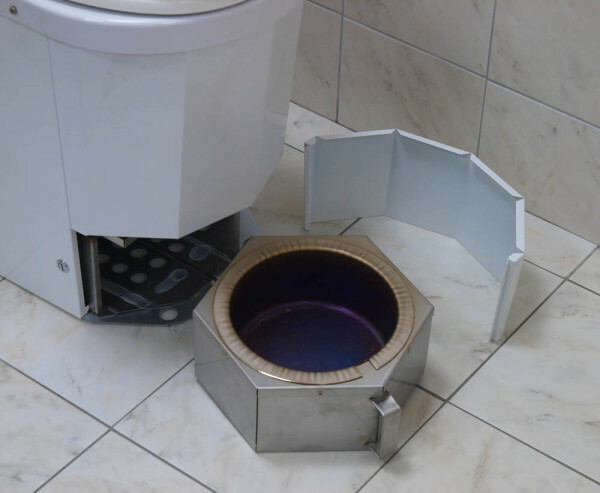
In this tray falls ash after incineration of waste
Advantages and disadvantages
Benefits:
- Bio-toilet is autonomous, it can be used in almost any building. Yes, some models require connection to the mains supply, ventilation or drainage, but all the same amount of work can not be compared with the arrangement of the stationary bathrooms.
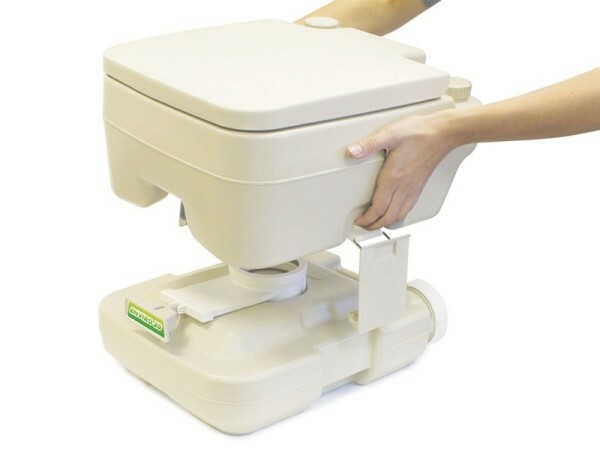
The compact dimensions of structures - an obvious plus
- Designs are relatively compact, which allows install them in relatively small rooms.
There is also a fairly large model with volume storage tank. But such a composting toilet is intended mainly for stationary use, and its reservoir usually do take out for easy cleaning and waste disposal.

Bio-toilet can be installed in any country house
- system service does not require significant time and cost. Waste or merge into a cesspool / sewer system, or composted with the possibility of use as a fertilizer.

Very easy to use system
Disadvantages:
- Bio-toilet you must either be connected to the ventilation system, or put up with the presence of the odor. Yes, it is a gentle - but still will.

On the street, this design is appropriate, but the smell in the house will still be
- Service, though infrequent, takes time. Yes and enjoyable process can not be named.
- For the purchase of ingredients for the filling of dry closet have to spend money on a regular basis, sometimes - very significant. Peat mixture for powder-closet worth much cheaper, but still have to buy it on a regular basis and in large quantities.
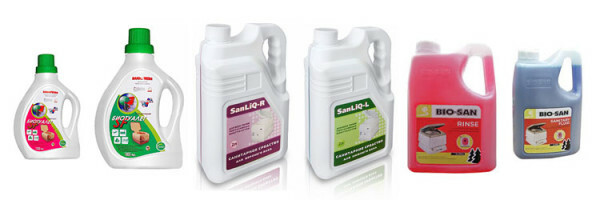
For the operation of the system is necessary to regularly update the reagents
- Models that work on electricity, are markedly different energy intensity (this is not only the thermal toilets). In addition, it is necessary to install a generator to at the wrong time during a power failure the device could use.
- Functionality homemade model is low, and the manufacturer's products are expensive. In particular this applies to electric models, but also peat toilet (Biolan, Ekomatik, etc.) will cost 12 to 30 thousand rubles, depending on the size and modification.
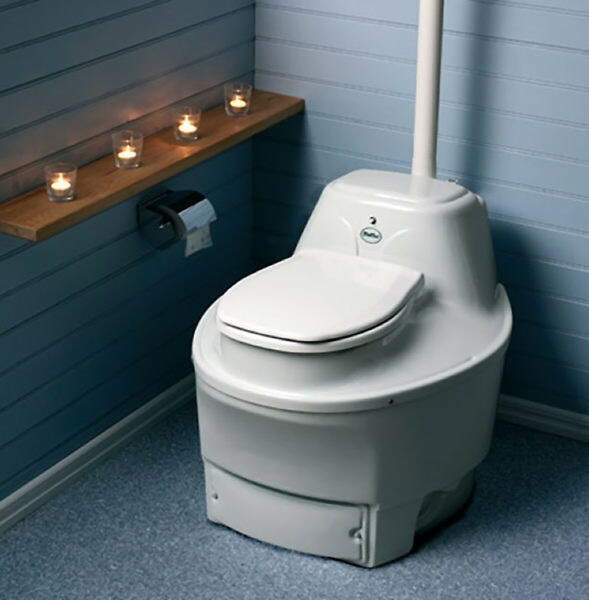
The cost of this model is very high
Conclusion can be made simple: Bio-toilet - it's effective, but still largely a forced decision. It is desirable to establish where there is no possibility to build a full bathroom with a septic tank, or at least a cesspool. In this situation, the quality bio-toilet is really indispensable!
independent production
water model
The simplest composting toilet for use in the country or in a country house can be made with their own hands. For use in such an environment suitable for both liquid and peat model.

On the basis of the bucket can be made impromptu biotoilet
Overview start with constructions in which the responsible for disinfection of waste water with special chemical additives:
- Dry closets We do on the basis of a special bucket, equipped with the seat and lid. These products are made from hard plastic, able to withstand the weight of a seated person, and are available in volume from 8-12 to 25-30 liters.
- You can be any suitable container instead of a special toilet-bucket. In this case, above it is desirable to build a wooden box with a toilet seat - only for ease of use.
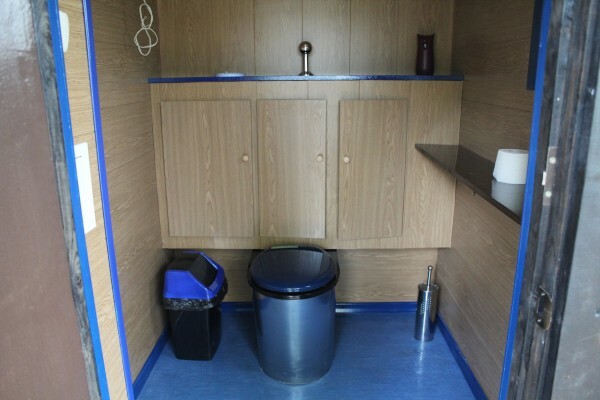
Set the bucket in a separate room
- Bucket set or under a canopy or in a special house, or in a separate room of the country house. In the latter case, the room in which is located a bio-toilet, must be isolated from the living area and is equipped with at least a simple ventilation.
- At the bottom of the bucket is filled in water with a reagent to "kill" the unpleasant odor and decomposing organic material. The water layer on the bottom of the vessel should be at least 15 cm.

Reagent for deodorization and decomposition of organic matter
It is desirable to establish close the canister with disinfecting solution ready product, so you can add it as needed.
- After composting toilet will be used for its intended purpose, it is added in small amount of water with a reagent. Then, cover the table surface with two or three layers of toilet paper. Paper acts a barrier to odors, does not float up solid particles and minimizes splashing during repeated use.

After emptying the wash tank, whereupon the liquid can be poured next portion
The convenience of this system is very doubtful, and practicality is not high: make a bucket, a minimum of three times a day. But for use in the autumn-winter period of such a bio-toilet is quite suitable.
On the one hand, in the cold season even waste in the house the smell is not so strong. On the other - it is better to poison the natural needs in the home than in the street blown stall.
peat model
Composting toilet composting on the basis of peat is much more practical. And is it not harder water. Instructions for the production of such a system involves the following steps:
- To start looking reservoir of sufficient volume. Intrahouse toilet usually done with the cumulative capacity of 30-50 liters, a street may have a volume of 100 liters or more. Actually, the limit is one: we should be able to somehow move the tank to clean it.

The plastic container used as the reservoir
Preference should be given tank made of a material resistant to corrosion. Typically, this is 95% of the plastic - either polyethylene or PVC. Metal constructions, even galvanized, enamelled or do not withstand prolonged contact with corrosive liquid environment.
- The house is set on the tank floor in a separate room with sound insulation and good ventilation. If the bio-toilet is installed outdoors, the container is placed on the floor or in a booth, or (depending on the volume) digged into the ground under the cabin.
- Above the reservoir erect box of boards on the frame of the timber. At the top of the box make a hole over which set the toilet seat with lid. The box set so that if necessary it can be pushed or open for extraction in the purification tank.
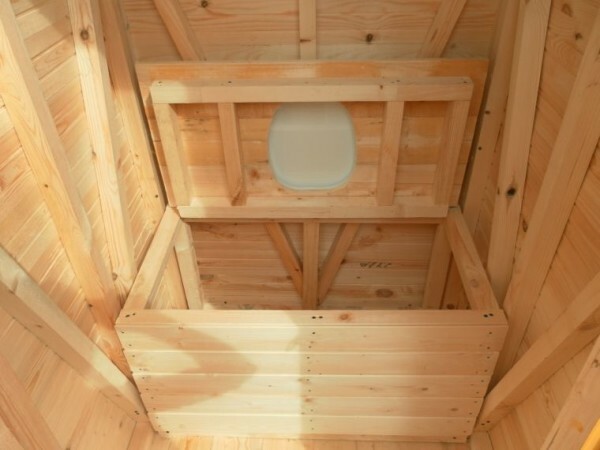
Wooden box with a commode opening
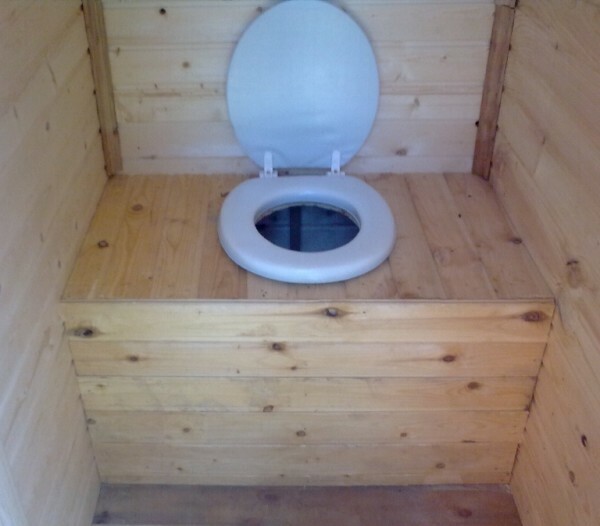
Photo boxes unopened
- Next establish container (plastic container or wooden box) with a mixture of peat. For containers on a cord or chain fastened scoop dispenser for filling torfosmesi in composting toilet after use.

Container with peat and dispenser
- Before the start of operation in the storage tank fall asleep about 5-10 cm of peat - he will serve as a basis for composting. Optionally pour a small amount of a biological preparation containing microorganisms which destroy organics.
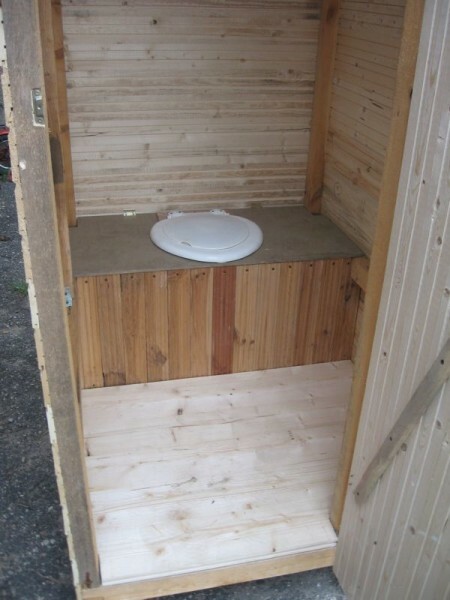
Street system, ready for use
The principle use of the system described above: after departure take necessities spout and filled into the reservoir a small quantity of peat. As the filling reservoir extract it and pour the mixture of peat and feces into a pit or a special box for composting. Followed by washing capacity of the hose and fall asleep in a bio-toilet next portion of the peat.
conclusion
Before you choose a bio-toilet at the cottage, should carefully study presented here describe the main varieties of such products, and to evaluate the pros and cons. In addition, the system can be made to - this will help the recommendations in the text and video in this article. All the questions you can ask in the comments below.


